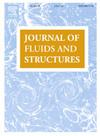各种钝体的流致振动:阻塞和壁面效应的综述
IF 3.4
2区 工程技术
Q1 ENGINEERING, MECHANICAL
引用次数: 0
摘要
在许多工程应用和性质中,受流体流动的钝体是不受约束的,或受两个平行壁或一个壁的约束。它们可能经历涡激振动(VIV)和/或驰骋取决于身体形状和约束程度。本文综述了不同截面(圆形、方形、圆角和矩形)的受限钝体的流激振动。综合了在不同质量比、阻尼比和雷诺数范围内,两壁(两壁-圆柱体相互作用)或一壁(一壁-圆柱体相互作用)的流动约束对振动响应、频率响应、锁定、气动力、旋涡脱落、运动轨迹、相位滞后、涡腔宽度、涡腔迟滞和驰骋的影响。对于圆柱体来说,堵塞比的增加降低了最大振动幅值,导致涡激振动宽度的缩小和涡激振动区向更小的减速区转移,并在初始分支和下分支之间引入了迟滞。对于方形圆柱体,堵塞比对振动幅值的影响不是直接的,而是取决于圆柱体质量比。较高的堵塞比抑制方形圆柱体的驰动。指出了文献中的研究空白,并提出了未来研究的方向。本文章由计算机程序翻译,如有差异,请以英文原文为准。
Flow-induced vibrations of various bluff bodies: a review of blockage and wall effects
Bluff bodies subjected to fluid flow are unconfined or confined by two parallel walls or by one wall in many engineering applications and nature. They may undergo vortex-induced vibration (VIV) and/or galloping depending on the body shape and the confinement degree. This paper presents a review of flow-induced vibrations of confined bluff bodies of different cross-sections, including circular, square, rounded-corner, and rectangular. Synthesized are the effects of the flow confinement by two walls (two-wall–cylinder interactions) or one wall (one-wall–cylinder interactions) on vibration response, frequency response, lock-in, aerodynamic force, vortex shedding, motion trajectory, phase lag, VIV width, hysteresis in VIV, and galloping at different ranges of mass ratio, damping ratio, and Reynolds number. For a circular cylinder, an increase in blockage ratio reduces the maximum vibration amplitude, causes a shrink in the VIV width and a shift in the VIV regime to smaller reduced velocities, and introduces hysteresis between initial and lower branches. For a square cylinder, the effect of blockage ratio on vibration amplitude is not straightforward but depends on the cylinder mass ratio. A higher blockage ratio suppresses galloping for a square cylinder. The research gap in the literature is pinpointed and put forward for future investigations.
求助全文
通过发布文献求助,成功后即可免费获取论文全文。
去求助
来源期刊

Journal of Fluids and Structures
工程技术-工程:机械
CiteScore
6.90
自引率
8.30%
发文量
173
审稿时长
65 days
期刊介绍:
The Journal of Fluids and Structures serves as a focal point and a forum for the exchange of ideas, for the many kinds of specialists and practitioners concerned with fluid–structure interactions and the dynamics of systems related thereto, in any field. One of its aims is to foster the cross–fertilization of ideas, methods and techniques in the various disciplines involved.
The journal publishes papers that present original and significant contributions on all aspects of the mechanical interactions between fluids and solids, regardless of scale.
 求助内容:
求助内容: 应助结果提醒方式:
应助结果提醒方式:


